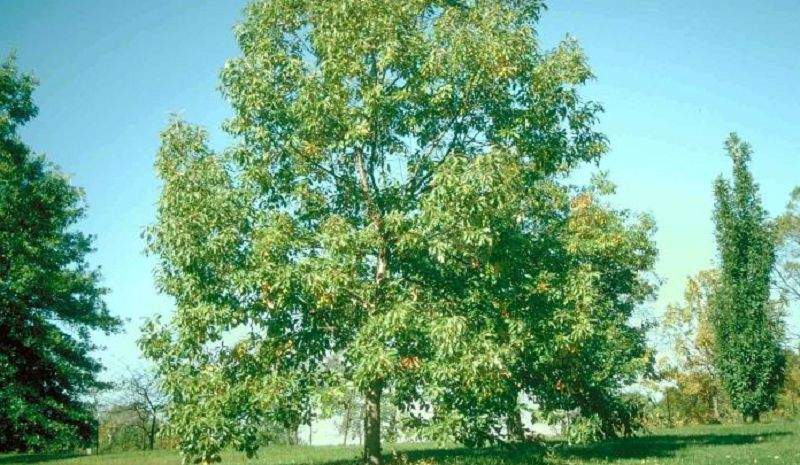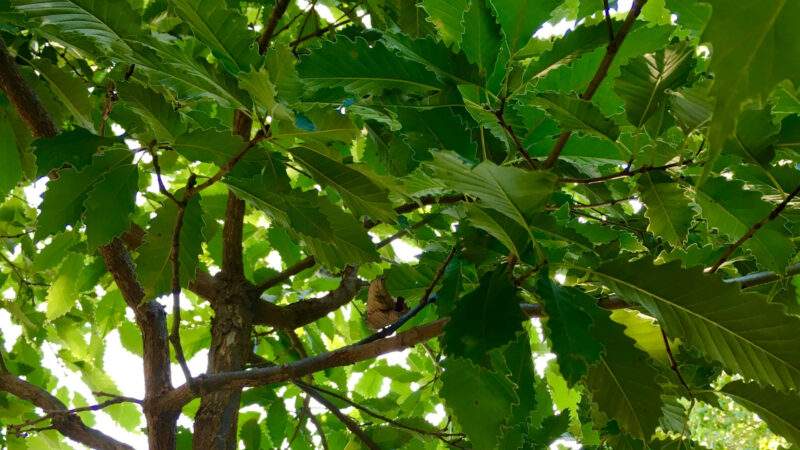20 Interesting Facts about The Chinkapin Oak Tree

The Chinkapin Oak Tree (Quercus muehlenbergii) is a deciduous tree that is native to North America. It is also known as the swamp white oak, water oak, or simply chinkapin. The Chinkapin Oak grows to a height of 50-60 feet and a width of 30-40 feet. The leaves are alternate, simple, and obovate in shape with a serrated margin. The top side of the leaf is green and glossy, while the bottom side is pale. The flowers are greenish-yellow and borne in clusters. The fruit is an acorn that matures in 18 months.
The Chinkapin Oak is found in woodlands, wetlands, and along streams from New York to northern Florida and west to Texas and Oklahoma. It prefers acidic, moist soils but can also grow in sandy or clay soils. The Chinkapin Oak is tolerant of flooding and drought. It is an important food source for wildlife, especially deer and squirrels. The acorns are also eaten by birds and small mammals.
The Chinkapin Oak has a strong wood that is used for furniture, flooring, and firewood. It is also used in the construction of buildings, bridges, and fencing.
1. The word Chinkapin comes from chestnut
The leaves of the Chinkapin oak resemble the leaves of the chestnut tree. The word Chinkapin is derived from the Algonquin word chechkipin, which means chestnut.
2. The Chinkapin Oak is also known as the swamp white oak
The Chinkapin oak is often confused with the swamp white oak (Quercus bicolor) because they have similar leaf shapes and growth habits. However, the Chinkapin oak has smaller leaves and acorns. The bark of the Chinkapin oak is also darker than the swamp white oak.
3. The Chinkapin Oak grows to a height of 50-60 feet
The Chinkapin Oak is a medium to a large sized tree that can grow up to 50-60 feet in height. The trunk is typically 3-4 feet in diameter.
4. The leaves are alternate, simple, and obovate in shape
The leaves of the Chinkapin Oak are alternate, simple, and obovate in shape with a serrated margin. The top side of the leaf is green and glossy, while the bottom side is pale. The leaves are 4-8 inches long and 2-4 inches wide.
5. The flowers are greenish-yellow and borne in clusters
The flowers of the Chinkapin Oak are greenish-yellow and borne in clusters. The flowers appear in May or June.

6. The fruit is an acorn that matures in 18 months
This acorn is a very popular food for squirrels and other animals. Each acorn takes about 18 months to develop.
7. The Chinkapin Oak is found New York to northern Florida and west to Texas and Oklahoma
The Chinkapin Oak is found in woodlands, wetlands, and along streams from New York to the north of Florida and west to Texas and Oklahoma. It prefers acidic, moist soils but can also grow in sandy or clay soils. The Chinkapin Oak is tolerant of flooding and drought.
8. It is an important food source for wildlife, especially deer and squirrels
The Chinkapin Oak is an important food source for wildlife, especially deer and squirrels. The acorns are also eaten by birds and small mammals.
9. The Chinkapin Oak has a strong wood that is used for furniture, flooring, and firewood
The wood of the Chinkapin Oak is solid and durable. It is often used for furniture, flooring, and firewood. Its wood profile is a cross between chestnut and oak. It’s used to make railroad ties, split-rail fences, and construction lumber.
Historically it was used to fuel steamships on the Ohio river.
10. It prefers alkaline soils
The Chinkapin Oak prefers alkaline soils with a pH of 6.5 to 7.5.

11. The Chinkapin Oak is in the white oak group
The Chinkapin Oak is in the white oak group (Quercus alba), which contains about 60 species of oaks worldwide. White oaks typically have lobed leaves and acorns that mature in one season. The wood is usually sold as a white oak.
12. The Chinkapin Oak is a host plant for the caterpillars of the Io moth
The Io moth (Automeris io) is a brightly colored moth that is found in North America. The caterpillars of this moth feed on the leaves of the Chinkapin Oak.
13. The Chinkapin Oak is a deciduous tree
The Chinkapin Oak is a deciduous tree, which means that it loses its leaves each year. The leaves typically turn yellow or brown before they are shed in the fall.
14. It has a lifespan of 100-150 years
The Chinkapin Oak has a lifespan of 100-150 years but can live longer than 400 years.
15. The Chinkapin Oak is a slow-growing tree
The Chinkapin Oak is a slow-growing tree. The tree typically takes 10-20 years to reach its full height.

16. The Chinkapin Oak is native to North America
The Chinkapin Oak is native to North America. It is found in the eastern United States and Canada.
17. The scientific name for the Chinkapin Oak is Quercus muehlenbergii
The scientific name for the Chinkapin Oak is Quercus muehlenbergii. This species was named after Henry Ernst Muehlenberg, a Pennsylvania botanist.
18. The Chinkapin Oak is also known as the yellow-wood, water oak, and swamp white oak
The Chinkapin Oak is also known as the yellowwood, water oak, and swamp white oak.
19. The Chinkapin Oak is a member of the Fagaceae family
The Chinkapin Oak is a Fagaceae family member, including beech and chestnut trees. It is related to beech trees. It grows both male and female flowers on the same tree. The male flowers are called “catkins,” and the female flowers are called “strobiles.”
20. The Chinkapin Oak is a famous landscaping tree
The Chinkapin Oak is a famous landscaping tree due to its attractive leaves and acorns. It is also tolerant of different soil types and locations.
What kind of animals eat the Chinkapin Oak and its products?
Chinkapin oak acorns are a popular food for many wildlife. They are commonly eaten by birds like grouse and turkey. Black bears and white-tailed deer also eat the acorns. Smaller animals like chipmunks, hogs, and squirrels. The leaves are edible as well, and cattle will eat them.
What wildlife benefits from Chinkapin Oak?
Hummingbirds will nest in these trees. The caterpillars of the Io moth feed on the leaves of the Chinkapin Oak. The tree is also a host plant for numerous other moths.
What are some uses for Chinkapin Oak?
The strong wood has been used for making railroad ties, split-rail fences, and construction lumber. It can also be used for smoking meats. The bark can be made into a yellow dye. The wood also makes it an ideal choice for wood barrels.
How do you identify a Chinkapin Oak?
The Chinkapin Oak can be identified by its smooth, yellow-brown bark. The leaves are dark green and have 7-9 lobes. They turn yellow or brown in the fall. The acorns are small and light brown with a short stalk. They mature in one season. The tree typically grows to be 20-30 feet tall.
What kind of habitat does a Chinkapin Oak Tree Prefer?
Habitat: Grows on rocky slopes and exposed bluffs. Commonly found in the east and southwest Iowa.
The Chinkapin grows on rocky slopes. They also grow on exposed bluffs. They are found in the United States, including in the east and southwest in Iowa. The Chinkapin is also found in Canada.
One of the best places to find the Chinkapin is in the Ozark Mountains. They are also found in other mountain ranges, including the Appalachians, Adirondacks, and Catskills. The tree grows in many different types of habitats, including mixed forests, deciduous forests, woodlands, and scrublands.
How do you plant a Chinkapin Oak tree?
Chinkapin Oaks are easy to grow from seed. Just plant the acorns in the fall and water them regularly. They will germinate in the spring. You can also buy young trees from a nursery. Plant them in an area with well-drained soil. Water them regularly for the first few years after planting.
How fast do Chinkapin Oak Trees grow?
A chinkapin oak will grow between 12″ to 24″ inches a year.
What languages does the word Chinkapin come from?
It is an Algonquin word.
What does the leaf look like?
The leaves of the Chinkapin oak are simple and alternate. They have 7 to 9 lobes and are dark green in color. The leaves turn yellow or brown in the fall.
What is the lifespan of a Chinkapin Oak tree?
The lifespan of a Chinkapin oak is between 200 to 300 years.
When do the flowers bloom?
The male flowers bloom in April and the female flowers bloom in May.
When do the acorns mature?
The acorns mature in September or October.
What is the bark like?
The bark is smooth and yellow-brown in color.
What are the roots like?
The roots are shallow and spreading. They often grow to be wider than the tree is tall.
How big is the biggest Chinkapin Oak?
The biggest Chinkapin oak is about 110 feet tall. It is located in Kentucky.
How big are Chinkapin Oaks when they mature?
Once Chinkapin Oaks reach about 50 feet, they are matured.
Do Chinkapin Oaks have invasive roots?
No, the roots of Chinkapin Oaks are not considered to be invasive.
How do you propagate the Chinkapin Oak?
Step by Step Instructions for Propagating a Chinkapin Oak
- Fill a planting container with well-drained potting mix.
- Place the acorn in the container and cover it with 1/4 inch of potting mix.
- Water the acorn until the potting mix is moist.
- Place the container in a cool location that receives indirect sunlight.
- Keep the potting mix moist but not wet.
- The acorn will germinate in 4 to 8 weeks.
- Transplant the seedling into a larger container or outdoors once it has 2 to 3 leaves.
- Water regularly until established.
Where are Chinkapin Oaks native to?
They are native to the Midwest area near the Chicago area.
What type of tree is a Chinkapin Oak?
A Chinkapin Oak is a deciduous tree.
What grow zones is the Chinkapin Oak suited for?
It is most well suited for zones 5, 6, and 7.
Are there old growth forests with Chinkapin oak?
Yes, there are old growth forests of Chinkapin oak in the Appalachian mountains.
The Wesselman Woods Nature Preserve in Evansville, Indiana is home to the oldest Chinkapin Oak in the state. The tree is estimated to be over 500 years old.
What are some tips on growing a Chinkapin oak?
Starting a young seedling in its permanent site is the best way to help it to grow its best. Amending the soil with some organic matter prior to planting will help the drainage and aeration of the roots. Chinkapin oaks need to be in an area with full sun for at least part of the day. They are not drought tolerant, so make sure to water during extended periods of dry weather. Fertilizing in early spring with a slow-release fertilizer is beneficial. Regular deep watering during droughts is necessary as well. Chinkapin oaks are relatively maintenance-free, but if you want to prune them, do so in late winter or early spring before new growth begins.






